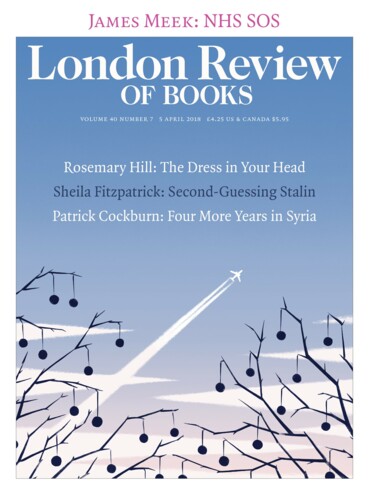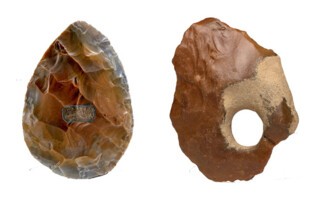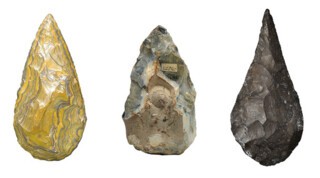Currently on view at the Nasher Sculpture Centre in Dallas is a show whose high ambitions gradually unfold from its title. First Sculpture: Handaxe to Figure Stone (until 28 April) has in its sights the deepest origins of art. The usual art historical strategy has been to tiptoe around the problem of where and how art, as we think of it, began, building the origin story on a few unprecedented objects considered in isolation. If you were to ask someone with an interest in such matters what they took to be the earliest surviving work of sculpture, the chances are that they would say the astonishing limestone ‘Venus’ discovered a century ago on the banks of the Danube not far from the Austrian village of Willendorf. Tiny yet massive, the figure’s fullness seems sculptural more or less by definition; its display of observation and exaggeration is so expert that, seen in the flesh, it’s a shock to realise how comfortably the carved stone could fit in your hand. Yet its talismanic immediacy makes it seem the embodiment of the impending arrival of Art.
Like the rest of her tribe, the Willendorf Venus is thought to have been carved some time between 28,000 and 24,000 bce, which is to say in the final ‘Upper’ phase of the Paleolithic period, the epoch that saw the great painted cycles at Altamira and Lascaux. For sheer vital splendour, these improbable survivals offer the most impressive testimony to art’s deepest origins we could possibly have hoped for. In the case of more ordinary prehistoric artefacts, however, a quite different narrative prevails. The story starts with the technological traces our hominin ancestors left in plenty: thousands on thousands of stone tools and weapons, the great majority in the bifacial form that since the 1880s has been prosaically termed a handaxe. The first recorded discovery of such an object occurred in June 1797 when the English antiquary John Frere caught sight of two marvellous examples deep in a hole dug by brick workers in Suffolk. Convinced that these were ‘weapons … used by a people who had not the use of metals’, Frere traced them to ‘a very remote period indeed, even beyond that of the present world’.
Since Frere’s day, knowledge of the type of object he found so alien has come on in leaps and bounds. Although Frere was right that the people who used them could not manipulate metal, he didn’t remark on the level of expertise – the sheer refinement – that governed their design. For hominins, the bifacial format, which took a variety of shapes, produced tools worth keeping. Both form and function became subjects of thought. It transpired that an axe could be flaked from a flint ‘core’ by means of a sequence of precisely struck blows (‘knapping’). From that first flurry of flakes (many possessed of razor-sharp edges of their own) issued a finely tapered symmetrical object usually in the shape of a teardrop, a thing clearly designed to be held in one hand, not two. Pace Frere, handaxes were made to dig, scrape and cut, rather than to stab, slit or chop. Such uses did not preclude their deployment as weapons, obviously, though their blades would have been most effective at arm’s length or closer, coming in for the kill.
In this account – the ‘man the toolmaker’ narrative – such chipped and knapped implements served as the principal tool used by Neanderthals (men and women) to master their world. What’s harder to comprehend is that knapped stones – axes, blades, spearheads and arrowheads – answered that purpose for a good million years. The proposal explored at the Nasher is that sculpture emerged from the gradual evolution of an efficiently functioning technology based in the skilled shaping of stone. And from that practice emerged a set of founding principles recognisable as the fundamentals of art.
That this argument has been pursued at the Nasher is due in part to the alliance struck by Jeremy Strick, director of the centre since 2009, and Tony Berlant, a Santa Monica-based artist who has spent long years collecting a strikingly wide range of worked and unworked stones from around the world. Some are included in the show. The current exhibition has also benefited from the involvement of Thomas Wynn, who teaches anthropology at the University of Colorado and is the co-author of How to Think like a Neanderthal (2012). The book’s answer is that Neanderthal cognition is thinking in stone. It involved not merely the discovery of how stone could be used, but also how to choose and prepare it efficiently, with a minimum of pain and difficulty. In other words, for the Neanderthal, thinking in stone meant not only the acquisition of a central skill – the skill we term knapping – but also all the related techniques and knowledge on which knapping relies. What stones are the best candidates for percussive shaping? At the Nasher there are pieces made of flint, jasper, limestone, quartzite, basalt, quartz and hornfels, a metamorphic rock whose German name reflects its extreme, i.e. ‘horny’, hardness. Which stones make the best hammers? What shapes are suitable? Can an edge be resharpened? Is it worth collecting a reserve of promising stones from which new tools might arise?
Knapping, in other words, is much more than the giving of form through the sequential subtraction of stone. According to Wynn, not only did all Neanderthals know how to knapp, but their shared expertise made for a culture in which materials and understanding were inextricably entwined. It’s not hard to see the link between Michelangelo liberating a body entrapped in a marble block, and the knapper, striking stone against stone, finding the fracture lines to separate flakes from an unshaped mass, so that the tool can emerge. Each successive strike responds to the one before it; knapping is an art of contingency that requires mind and body to respond to the stone as it reveals itself. The process discovers what is possible, as opposed to preordained.
This distinction is crucial. Although the Nasher show makes the case that hominins valued certain stones – shapes found and left essentially unworked – because in them they recognised likeness and ambiguity, this is not its strongest claim. Clearly we can be more confident about how hominins thought when we know what they did. Which leads directly to the question: is a knapped axe art? Thinking with and through materials is something that craftspeople do all the time. The Nasher exhibition, however, isn’t merely asking its viewers to revel in the evidence of practical skill. The objects are installed as an animate assembly, each handaxe upright and individualised, rather than lying inertly in a polished vitrine. The tactic pays off. To enter the gallery is to come face to face with unique and beautiful things, each deftly knapped from a great spectrum of stones. Some seem glassy, others glow, those in quartz are crystalline, while the gneiss axe from Mauritania flaunts a crazy quilt of stripes in honey yellow and warm earthy brown.
But even the most exuberant combinations of colour, surface and texture don’t necessarily make an ordinary object a sculpture. If a handaxe qualifies, it is as both a spatial and a bodily thing. It is made to be held, and its shape declares that purpose, though in ways that aren’t easy to put into words. Imagine a two-sided tool that is also bilaterally symmetrical – something like a broad-bladed knife, though with one crucial difference. Though planar, the back of each handlaxe is is fuller than the front. There a slight bulge, a rounding, which seems both to echo and await its user’s cupped hand.
One persuasive reason to see at least some handaxes as sculpture stems from their nuanced and exacting display of formal goals. Their consistent use of symmetry is a case in point, given that such equilibrium isn’t particularly helpful where skinning prey and stripping bones are concerned. A double-edged tool doubles the risk of injury to the palm or fingers of the working hand. By these lights symmetrical axes put the threat of injury second to the pleasure presented by a well-balanced form.
These and other features help to explain not only why some handaxes seem exceptional but also why practical necessity alone doesn’t seem a sufficient explanation of their materials and forms. Strikingly, many seem not to have been used. Others were evidently designed to set off some remarkable feature – a hole in a flint, perhaps, or a fossilised shell. One of the best known of all handaxes, discovered in 1911 somewhere near the village of West Tofts in Norfolk, not only features the delicate flutes of the bivalve Spondylus spinosus, or spiny oyster, but also frames the fossil in a stony proscenium: with a few deft blows the decorative element has been brought into relief. It was produced, the experts say, somewhere between 500,000 and 300,000 years ago. The area where it was found, though archeologically speaking one of the richest in the country, has been inaccessible since 1942, when it was closed to visitors by the Ministry of Defence.
Is it useful to see the West Tofts axe as sculpture? What about the earlier group of flint axes excavated in Boxgrove, outside Chichester in West Sussex, in the 1980s and 1990s? The evidence discovered on the Pleistocene site includes the bones of fish, birds, reptiles, amphibians and mammals, among them creatures – bear, hyena, rhinoceros, elephant – no longer indigenous and sometimes extinct. All these remains tell a story, but the most vivid centres on a group of hominin hunters who brought down and butchered a horse using axes knapped and then abandoned on site. Millennia later, the discards remained undisturbed, yielding an enormous amount of information on their making and use. We can be certain they were used against animals grazing and hunting on site. In the aftermath, not only bare bones but also axes and flakes were abandoned where they fell. Perhaps the hunters, now laden with fresh meat, needed to lighten their load.
It’s worth asking why a set of Boxgrove axes (ten in total) is included in a show that concerns the earliest origins of sculpture. Their instrumental roots and purposes are manifestly clear. But though not made as ‘sculpture’, they count among the most striking objects the exhibition puts on view. Quickly made on site in the course of a hunt, their shapes and surfaces have an economy, a tension, that seems to go to the essence of the stone. They are the only ones installed in Dallas so as to lie flat, in a circular vitrine. Shown ‘at rest’ – artefacts not art – each still looks uncannily animate, as if it was made to record the stony shadow of a working hand. Perhaps the caves at Altamira, with their famous walls of handprints emerging from brown pigment, are not as far from Sussex as we think.
Send Letters To:
The Editor
London Review of Books,
28 Little Russell Street
London, WC1A 2HN
letters@lrb.co.uk
Please include name, address, and a telephone number.



